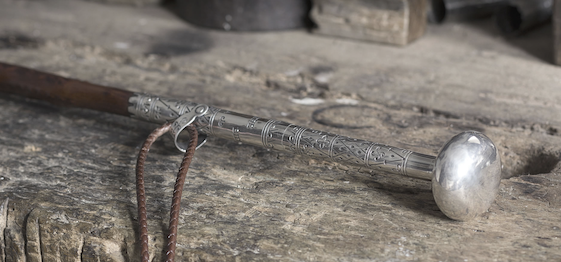Basque culture is ubiquitous with numerous unique symbols and iconography — the lauburu, the eguzkilore, the omnipresent font that decorates store fronts, and so much more. One of the most unique Basque symbols is the makila, a walking stick that is, today, ceremonially used to recognize important persons. However, did you know that it can take upwards of twenty years to make a makila? The art and craftsmanship behind the makila are quite outstanding.

- A makila serves not only as a walking stick, but also a weapon. The handle, often made of animal horn, can be used as a bludgeoning weapon while it can be held by the handle and be swung at an opponent or dangerous animal. However, buried in the shaft is a small sword or spike that can be revealed by removing the top, creating an effective stabbing weapon. There is some evidence that there used to be codified makila fights and even that Napoleon had a regiment of makilkaris for hand-to-hand combat.
- The makila is an important cultural symbol for the Basques. It is often given as a form of recognition to dignitaries or other important visitors. A few notable people who have been honored with the gift of a makila include US President Ronald Reagan, Pope John Paul II, the author Bernardo Atxaga, and my father-in-law.
- A makila can take twenty years to make. The process starts with the artisan finding a tree. While many woods can be used to make a makila, including beech, gorse or argoma wood, juniper, and holly, medlar is the common choice. A branch is carved with designs while it is still alive and part of the tree. The branch is then left alone until it heals and the design becomes part of its surface. After the branches are cut and baked, they are left to age upwards of ten years. This wooden shaft is then adorned with metal casings, usually silver or brass, that are engraved with Basque symbols such as the lauburu.
- There is a story that, in 1879, a cache of silver coins was discovered, some of which were sold to a local hairdresser who then used them to crown makilas. It turns out those coins were over 2000 years old.
- The family-owned business Makhila Ainciart Bergara, making makilas since 1780, was a finalist for the 2021 ‘Family is Sustainability‘, awarded by Primum Familiae Vini for “excellence in sustainability, innovation, craftsmanship and the successful transmission of responsibility and commitment from one generation to the next.” Unfortunately, they were not the winner, but their inclusion in the list demonstrates the high esteem the traditional Basque art of the makila has.
Primary sources: Estornés Lasa, Bernardo. MAKILLA. Enciclopedia Auñamendi, 2021. Available at: http://aunamendi.eusko-ikaskuntza.eus/es/makilla/ar-91243/; Makila, Wikipedia; Makilas, el bastón de jefe vasco que se hace a mano y se tarda mas de 15 años en fabricar, Vanity Fair.
Discover more from Buber's Basque Page
Subscribe to get the latest posts sent to your email.


Recently i have written a brief article about makilas on my blog. My neighboure Beñat is one of this last artisans. I leave you link here.
https://sansebastiantrips.com/last-makila-artisan-basque-country/
Thanks Alex! Mil esker!